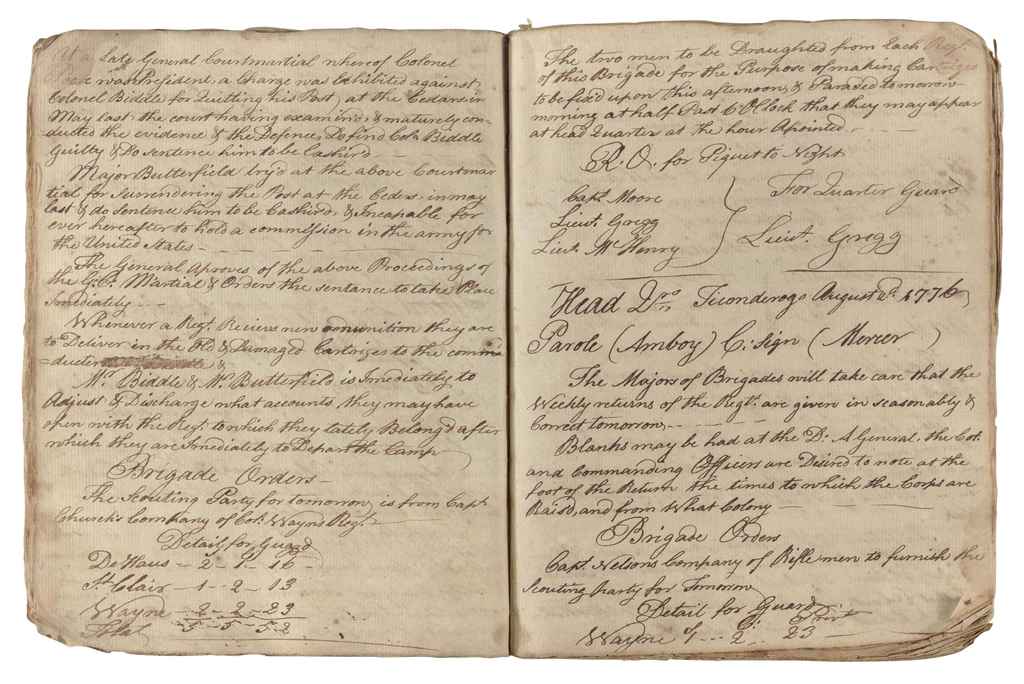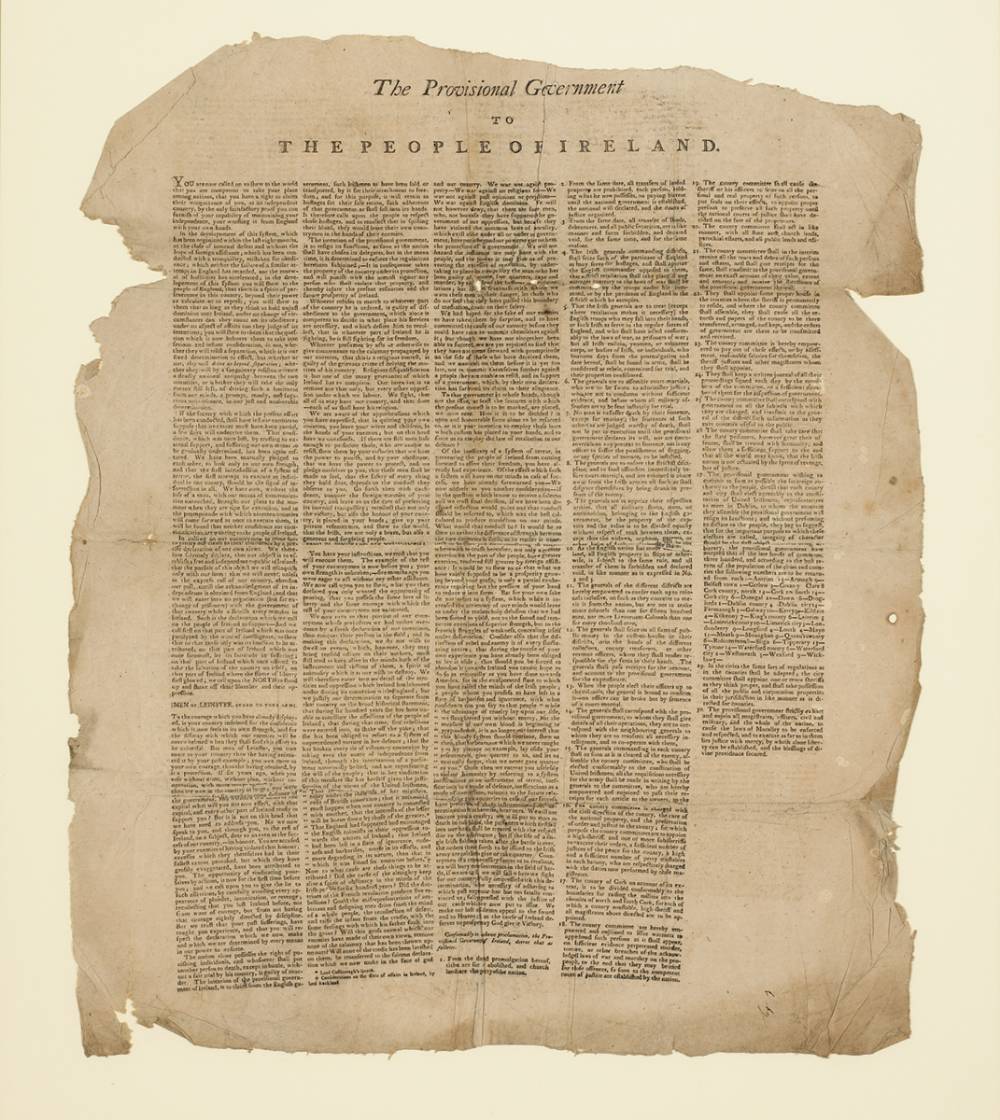Letter 2pp, Hanover(?), 15 Jan. 1810 to Genl. James O'Hara from Arthur St. Clair, regarding a debt owed to O'Hara. A second letter is 1p, Philadelphia, 23 Mar. 1810, addressed to General St. Clair from Gen. John Gardiner, in which Gardiner declines to take the "property at Ligonier being so far distant it would of course be out of my power to pay the least attention [to it]." The third document is a sale of land in Ross County, Ohio from Cary A. Trimble and his wife Anne to Lewis W. and Elizabeth M. Foulke, 21 Nov. 1862. Arthur St. Clair (1736-1818) was born in Scotland. He seems to have studied for a while at the University of Edinburgh, then with William Hunter, but little is known of his life before the military. He enlisted in the British army in 1757 and was sent to North America during the French and Indian War. He retired in 1762 and purchased 400 acres in the Ligonier Valley in western Pennsylvania, likely the land referenced in General Gardiner's letter. He became a patriot as the Revolutionary War loomed, and he was appointed colonel in the Continental Army. By 1777 he had risen to the rank of Brigadier General and was given command of Fort Ticonderoga. In a move that seems to presage the remainder of his career, he abandoned the fort, leaving it to the British. He was not trusted with a major command again, even though a court-martial found him not guilty of charges associated with the abandonment. After the war, St. Clair was elected to the Congress of the Confederation (the Continental Congress after ratification of the Articles of Confederation), and served as its President in 1787. He was then appointed Governor of the Northwest Territory, a position he held until 1802. Before the Revolution, St. Clair had tried to establish friendly, economic relations with native peoples (and some think the settlers in western PA were less harassed by Indian attacks than settlers in Ohio and Indiana because of this). However, problems with Indian attacks became one of St. Clair's greatest issues as governor of the territory. He tried to negotiate peacefully, but the native peoples either were not included in treaty negotiations (or those who were included did not represent their people) or refused to honor treaties that were signed. Forts were established and manned by 1500 troops, sent under General Josiah Harmar to defeat the natives. However, in a push against the Miami village near Fort Wayne in 1790, Blue Jacket and Little Turtle defeated Harmar. St. Clair himself then decided to lead troops against the natives, and he, too, was defeated by Little Turtle and his allies. Under Washington's pressure, St. Clair resigned from the army but remained governor of the Northwest Territory, and still had "Indian problems." Washington sent "Mad" Anthony Wayne to battle the Shawnee and Miami warriors. The natives were defeated at the Battle of Fallen Timbers in 1794, and most signed the Treaty of Greenville, giving up most of their land in Ohio. St. Clair was a "law and order" governor, who was responsible for the adoption of Maxwell's Code (see lot 465, Cowan's Western and Historic Americana, Dec. 6-7, 2007). He was a Federalist who favored an aristocratic government, but the settlers in the territory were far more democratic and populist (not surprisingly). And although he pushed for Ohio statehood, he tried to manipulate the set-up so the new states (he favored two rather than one) could be Federalist-controlled. However, President Jefferson, as founder of the Democratic-Republican (populist) Party, had other ideas. He removed St. Clair as governor and Ohio entered the union as one state. St. Clair retired to his Pennsylvania home. Always liberal with his money, he loaned much to friends and family. When Congress failed to reimburse him for expenses incurred as governor of the Northwest Territory, he ran into financial difficulties, as the first letter indicates, and unable to meet his obligations. He lost most of his fortunes land
Letter 2pp, Hanover(?), 15 Jan. 1810 to Genl. James O'Hara from Arthur St. Clair, regarding a debt owed to O'Hara. A second letter is 1p, Philadelphia, 23 Mar. 1810, addressed to General St. Clair from Gen. John Gardiner, in which Gardiner declines to take the "property at Ligonier being so far distant it would of course be out of my power to pay the least attention [to it]." The third document is a sale of land in Ross County, Ohio from Cary A. Trimble and his wife Anne to Lewis W. and Elizabeth M. Foulke, 21 Nov. 1862. Arthur St. Clair (1736-1818) was born in Scotland. He seems to have studied for a while at the University of Edinburgh, then with William Hunter, but little is known of his life before the military. He enlisted in the British army in 1757 and was sent to North America during the French and Indian War. He retired in 1762 and purchased 400 acres in the Ligonier Valley in western Pennsylvania, likely the land referenced in General Gardiner's letter. He became a patriot as the Revolutionary War loomed, and he was appointed colonel in the Continental Army. By 1777 he had risen to the rank of Brigadier General and was given command of Fort Ticonderoga. In a move that seems to presage the remainder of his career, he abandoned the fort, leaving it to the British. He was not trusted with a major command again, even though a court-martial found him not guilty of charges associated with the abandonment. After the war, St. Clair was elected to the Congress of the Confederation (the Continental Congress after ratification of the Articles of Confederation), and served as its President in 1787. He was then appointed Governor of the Northwest Territory, a position he held until 1802. Before the Revolution, St. Clair had tried to establish friendly, economic relations with native peoples (and some think the settlers in western PA were less harassed by Indian attacks than settlers in Ohio and Indiana because of this). However, problems with Indian attacks became one of St. Clair's greatest issues as governor of the territory. He tried to negotiate peacefully, but the native peoples either were not included in treaty negotiations (or those who were included did not represent their people) or refused to honor treaties that were signed. Forts were established and manned by 1500 troops, sent under General Josiah Harmar to defeat the natives. However, in a push against the Miami village near Fort Wayne in 1790, Blue Jacket and Little Turtle defeated Harmar. St. Clair himself then decided to lead troops against the natives, and he, too, was defeated by Little Turtle and his allies. Under Washington's pressure, St. Clair resigned from the army but remained governor of the Northwest Territory, and still had "Indian problems." Washington sent "Mad" Anthony Wayne to battle the Shawnee and Miami warriors. The natives were defeated at the Battle of Fallen Timbers in 1794, and most signed the Treaty of Greenville, giving up most of their land in Ohio. St. Clair was a "law and order" governor, who was responsible for the adoption of Maxwell's Code (see lot 465, Cowan's Western and Historic Americana, Dec. 6-7, 2007). He was a Federalist who favored an aristocratic government, but the settlers in the territory were far more democratic and populist (not surprisingly). And although he pushed for Ohio statehood, he tried to manipulate the set-up so the new states (he favored two rather than one) could be Federalist-controlled. However, President Jefferson, as founder of the Democratic-Republican (populist) Party, had other ideas. He removed St. Clair as governor and Ohio entered the union as one state. St. Clair retired to his Pennsylvania home. Always liberal with his money, he loaned much to friends and family. When Congress failed to reimburse him for expenses incurred as governor of the Northwest Territory, he ran into financial difficulties, as the first letter indicates, and unable to meet his obligations. He lost most of his fortunes land















Try LotSearch and its premium features for 7 days - without any costs!
Be notified automatically about new items in upcoming auctions.
Create an alert